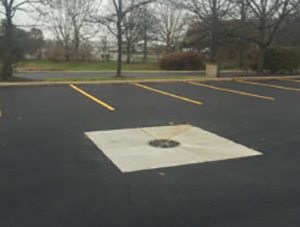

Take the Quiz and Catch Problems Now!

While April showers are great for May flowers, the excess rainwater may not be so good for your parking lots. In fact, the number-one enemy of asphalt pavement is water. Why? Because it permeates cracks and, over time, will erode the base or sub-base of your pavement.
Sealing cracks will help alleviate this; but, not if the cracks are located in areas where ponding occurs. If you notice standing water on your parking lots, it is important to determine the root cause. Failing to address this will result in substantial costs in structural repair.
Take the Catch Basin Quiz:
- Where are your catch basins? It is important to inspect your pavement assets on a routine basis. During your walk-through, take note of the location of catch basins. They should exist in low-lying areas to ensure proper drainage. If pavement has settled around a catch basin, for example, it is possible the catch basin is now positioned higher than the surrounding asphalt, which impedes its ability to function.
- How many catch basins do you have? There is no magic number and the answer will vary based on size and slope of your parking lot. But, generally speaking, catch basins should be strategically placed in low-lying areas throughout your parking lot. If sufficient drainage does not exist, consider installing additional catch basins.
- When was the last time you had your catch basins cleaned? Catch basins need to be cleaned periodically to ensure they’re free of debris such as wet leaves, which can easily clog the drain. Frequency of cleaning may vary depending on factors such as climate or vegetation that is present. For example, if there are a lot of trees on or near your parking lot and the weather is especially windy or rainy, cleaning should occur more often to remove fallen leaves.
- When was the last time you had your catch basins serviced? Catch basins themselves can experience wear and tear and, as a result, will not work properly. For example, the frame may shift and need adjusting. Or, the concrete rings, which are the weakest part of the structure, may have deteriorated and need replacing.
- Are your catch basins surrounded by asphalt or concrete? Aside from the proper number in the right location, cleaned and regularly serviced, there is one final factor to consider. If asphalt surrounds your catch basins, there is still the potential hazard of water deterioration at the structure and/or pipe level. Water infiltration weakens asphalt base material and can cause a sinkhole on the surface. Although more expensive up front, concrete has approximately five times the life span of asphalt. And, depending on reinforcement selection (fiber, wire, rebar, etc.), concrete provides much more structural integrity and strength surrounding the catch basin. Therefore, it is strongly recommended to secure catch basins with concrete collars. These collars should measure 6’ X 6’ and 6” in depth.
There’s no doubt about it—catch basins perform a much-needed function on your parking lots. And, as wet weather becomes more prevalent, now is the perfect time to catch defects and make necessary repairs.
Don’t wait! Contact Let’s Pave now for help with catch basins and all your stormwater management needs.



